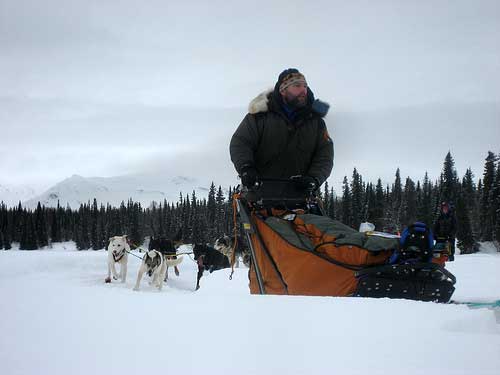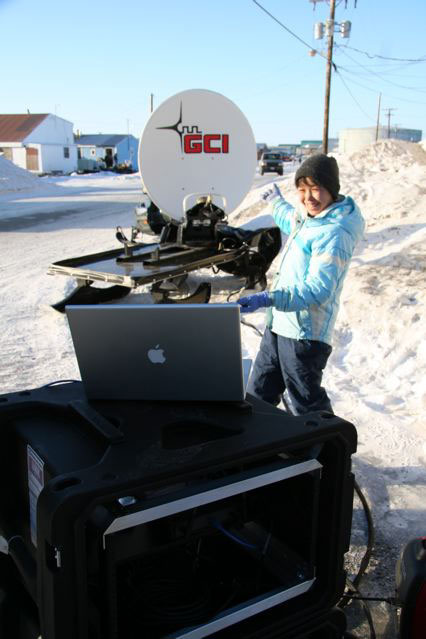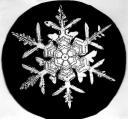Rick Holt, a 2008 Iditarod finisher, near Finger Lake. Photo courtesy of John Concilus.
It’s that time again – the 37th annual Iditarod Sled Dog Race across Alaska will begin at 10 am, March 7, 2009. This ceremonial start is in downtown Anchorage, with the competitive start (or “restart”) scheduled for Sunday, March 8, 2009 in Willow, Alaska.
The Iditarod is an exciting basis for an interdisciplinary unit blending geography, language arts, math, and even art. For more ideas on creating an Iditarod lesson or unit, see our blog post, The Last Great Race: Teaching the Iditarod.
In addition, the Bering Strait School District (located along the Iditarod trail) provides free mushing resources, lessons, and live race coverage from a Student Broadcast Team through their annual IditaProject. They use a wiki to provide free resources and options for web-based participation. Download a pdf document with an overview of the project.
A student from the Bering Strait School District provides live race coverage through the IditaProject. Photo courtesy of John Concilus.
Daily Live Race Updates will begin Monday, March 9. 9 am and 3 pm Alaska Time, except when this conflicts with the thematic broadcast schedule (below). All updates are available via Flash Stream.
Thematic Broadcasts are scheduled at 8 am and 1 pm Alaska Time on the following dates and topics:
March 9: Background and Race Start Coverage
March 12: History and Culture
March 16: Mushing Math
March 17: Veterinary Medicine and Sled Dog Racing
March 18: Race Statistics and Records
March 19: Race Finish and Wrap Up
Finally, the wiki also includes forums on mushing, Iditarod history, and support for students and teachers participating in the IditaProject.
There are a variety of ways to participate in the project, depending on your interest, time, and technological capabilities. Classes around the country can:
Visit the site for updates and themed broadcasts. No registration required!
Register for IditaProject. Watch live streams of the Student Broadcast Team and Race Updates, ask questions of special questions via Skype, steer the checkpoint webcam in Unalkleet, contribute directly to the wiki pages, participate in the online course via Moodle, and use the “Students Only” forum (run by students in the Inupiaq and Yup’ik villages). Registration is free, and requires a good web connection, a browser that displays Flash, and the ability to install Skype and VLC Player (free software).
Participate in video conferences. A limited number of schools and classrooms can participate by two-way video conference. This requires some planning, and coordination with the school district’s technology staff to ensure the devices (Tandberg or Polycom are most common) can talk to one another. Schools participating this way will be able to more openly interact with staff and students during the themed broadcasts, as well as with special guests. All other IditaProject resources are available to these schools and classrooms as well. To register for video conferences, use the same form as for IditaProject and select the “Participate Live” or “Participate Live and Online” options.
Of course, space is limited and the race begins soon – so register today!
Have a lesson, unit, or online Iditarod resource you’d like to share? Post a comment – we’d love to hear from you!







 Follow us on Twitter
Follow us on Twitter


Posted in Topics: Animals, Arctic, Education, Polar News & Notes, Reading, Science, Technology, Upcoming Opportunities, Writing, social studies
No Comments